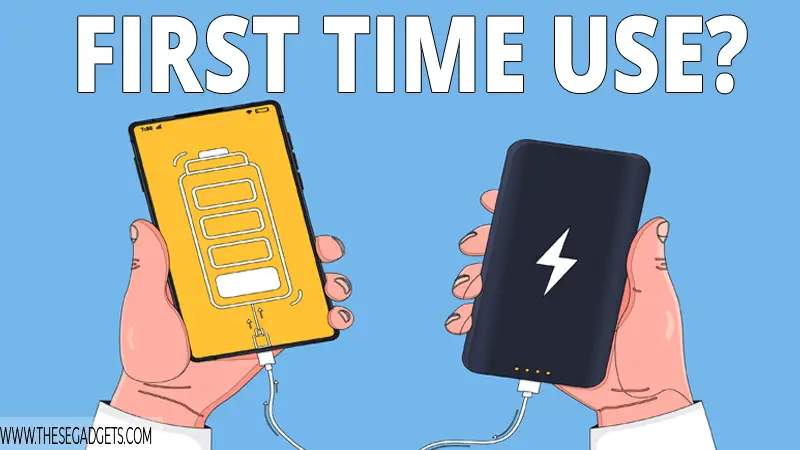To use the power bank for the first time, read the user manual, learn about the charging ports and recommended charging cables, fully charge the power bank, and use adequate ports to charge over devices.
To maintain a power bank, avoid strong it in extremely high or low temperatures, don’t use low-quality charging cables, and avoid fully discharging the battery.
Contents
How To Use a Power Bank For The First Time?
Using a power bank isn’t hard, but there are a few things you should do before first use. Reading the manual and fully charging the power bank before first use is a must.
Read The User Manual
A user manual is a printed document provided by the manufacturer of a product that contains information and instructions on how to safely and effectively use the product. It’s usually included in the packaging.
You must read the user manual of the power bank before using it.
The things you must read in the user manual of the power bank are as follows.
- The Charger You Need: The user manual will list the charger type you must use, the recommended power output for the charger, the wall charger you need, and the charging time for your power bank.
- LED Lights – If your power bank has LED lights, the user manual will list all the LED lights and explain what each of these LED lights can indicate. It will also show different colors the LED light may have and their meanings.
- Specifications: In the user manual you will see all the specifications of your power bank, including the battery capacity, dimension of the device, compatible devices, and input/output USB ports.
- Warranty – You will be able to see information about the warranty of the device.
- Safety Instructions: Some user manuals will include safety instructions to follow while using the power bank. This may include information about charging overtime, overcharging, and storage recommendations.
- Operation Instructions: The manufacturer provides an illustrated image of the power bank, the image will show where the buttons and ports are located and their uses. The image will also show the power output of each port.
- Important Notes: The user manual contains important notes that will show you: how to recycle the battery if needed. You will be able to know if the battery supports “Passthrough” charging, compatible devices, and much more.
You should always follow the guidelines you read in the user manual, even if they are different from other power banks you had before. For example, some power banks require you to fully charge the battery before first use, while some don’t.
Power Bank First-Time Charge
Charge the power bank fully before the first-time use. This ensures that the battery has reached its maximum capacity and is ready to provide a full charging performance. When you receive a power bank, it’s not fully charged because of storage and transportation process, or because of self-discharge.
To charge the power bank, use the charger that the device came with. If the power bank didn’t come with a provided charging cable, read the user manual to know the recommended power output for the charger and use a charger with the exact power output. In the user manual, you will also see the recommended charging time for the power bank.
To know the battery power level of the power bank, check the battery indicator LED lights. For instance, if the power bank has 4 battery indicator LED lights, each light will indicate 25% of charge. So, if 3 lights are powered up, it means the battery is approximately 75%.
The higher the battery capacity (mAh), the longer it takes to fully charge. To find the exact time your power bank needs to charge, use this formula:
Charge Time = (mAh of your Powerbank)/(mA of the Charger or Adapter)+10%
Power Bank First-Time Use
After fully charging the power bank, you can use it to charge your electronic devices. A power bank will have different input/output charging ports, such as USB-C port and AC/DC port. Read the user manual to know about the charging ports of your device.
Use the appropriate charging cable for your device and connect it to one of the USB ports on the power bank. Some power banks come with different fast-charge technologies such as Power Delivery (PD), Quick Charge, or Anker’s PowerIQ. But, in order to use these technologies, the device you are charging should be compatible with these technologies too.
You can find fast-speed technologies in power banks with a high charging capacity (20000mAh+). That’s because high-charging capacity power banks are used to charge large devices, such as a laptop, and having a high power output is a must. These power banks come with AC/DC ports that allow you to connect a laptop directly to the power bank and charge it.
Power Bank Maintenance Tips
To maintain a power bank properly, do the following.
- Avoid Storing The Power Bank in Hot Temperatures – Extreme high or low temperatures will decrease the battery performance and capacity. It’s best to store power banks in a cool and dry environment away from moisture.
- Avoid Using Low-Quality Cables – Don’t use low-quality or cheap charging cables to charge the power bank. Cheap charging cables don’t have the recommended power output and will damage the battery.
- Avoid Physical Damage – Physical damage can damage the internal hardware parts of the power bank, including the battery.
- Avoid Full Discharge – A full discharge will decrease the battery’s performance and capacity. If not in use, it’s recommended to top up the battery power every 2-3 months.
